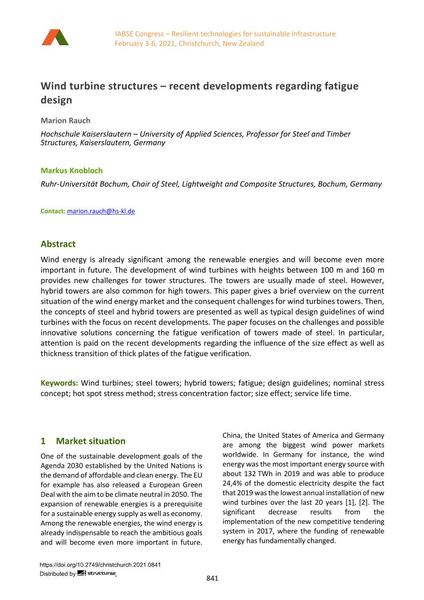Wind turbine structures – recent developments regarding fatigue design

|
|
|||||||||||
Bibliografische Angaben
| Autor(en): |
Marion Rauch
(Hochschule Kaiserslautern – University of Applied Sciences, Professor for Steel and Timber Structures, Kaiserslautern, Germany)
Markus Knobloch (Ruhr-Universität Bochum, Chair of Steel, Lightweight and Composite Structures, Bochum, Germany) |
||||
|---|---|---|---|---|---|
| Medium: | Tagungsbeitrag | ||||
| Sprache(n): | Englisch | ||||
| Tagung: | IABSE Congress: Resilient technologies for sustainable infrastructure, Christchurch, New Zealand, 3-5 February 2021 | ||||
| Veröffentlicht in: | IABSE Congress Christchurch 2020 | ||||
|
|||||
| Seite(n): | 841-848 | ||||
| Anzahl der Seiten (im PDF): | 8 | ||||
| DOI: | 10.2749/christchurch.2021.0841 | ||||
| Abstrakt: |
Wind energy is already significant among the renewable energies and will become even more important in future. The development of wind turbines with heights between 100 m and 160 m provides new challenges for tower structures. The towers are usually made of steel. However, hybrid towers are also common for high towers. This paper gives a brief overview on the current situation of the wind energy market and the consequent challenges for wind turbines towers. Then, the concepts of steel and hybrid towers are presented as well as typical design guidelines of wind turbines with the focus on recent developments. The paper focuses on the challenges and possible innovative solutions concerning the fatigue verification of towers made of steel. In particular, attention is paid on the recent developments regarding the influence of the size effect as well as thickness transition of thick plates of the fatigue verification. |
||||
| Stichwörter: |
Ermüdung Grösseneffekt Windkraftanlagen Hybridtürme Nennspannungskonzept
|
||||
